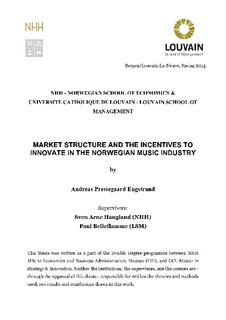Market structure and the incentives to innovate in the Norwegian music industry
Master thesis
Permanent lenke
http://hdl.handle.net/11250/196748Utgivelsesdato
2013Metadata
Vis full innførselSamlinger
- Master Thesis [4372]
Sammendrag
In this thesis, I study market structure and incentives to innovate in the Norwegian
music industry. The industry has gone through significant changes since the year
2000. Every part of the value chain has been disrupted by technology, and the
barriers to entry have decreased. However, major labels seem to have kept their
market share. I define product and process innovation as respectively the release of a
new artist and the release of a subsequent album. A product innovation gives the
label the ability to release subsequent process innovations, which is needed for the
label to recoup the investment of the product innovation. I demonstrate how market
structure affects the incentives to invest in product and process innovation by using a
logistic regression. My results show that independent labels invest two times more
than major labels in product innovations. The objective for all labels is to release a
product in the market with an innovative sound. The major labels will benefit from
the first innovation by releasing multiple subsequent process innovations that allow
them to benefit from diminishing cost. The independent label will release the first
album, but cannot compete in the market for the second album because of lack of
capital, less access to promotion channels and a small existing music catalogue.
Competition in process innovations is too intense, so the independent labels will
therefore continue to compete in product innovations by targeting the subculture
and re-segmenting their portion of the market while major labels reap the larger
benefits from process innovations, which maintains their market share.
